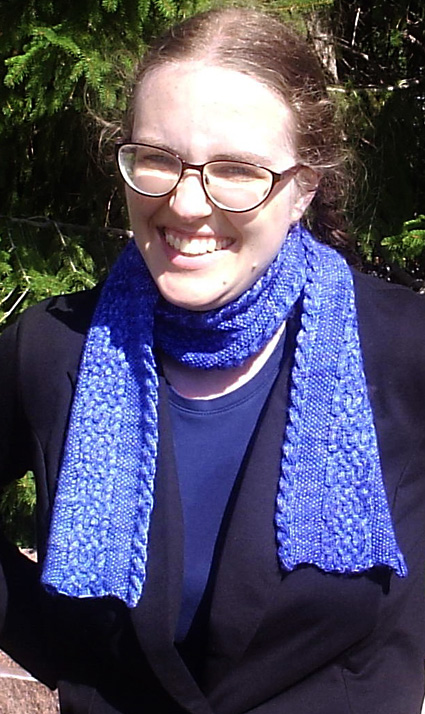

|
|
|

Cables look wonderful on hats. They look wonderful on socks, or on gloves, or on sweaters. They even look pretty good on pillows and blankets. But one place they don’t always look so good is the simple rectangular scarf. Cables tend to have one side that looks intricate and beautiful, and one side that looks much worse. It is easy to arrange a hat, or a sock, or a sweater, or even a blanket, so that only one side is visible. A scarf? It's quite a bit harder. So I started thinking about reversible cables. I've made a few scarves with reversible cables before, but for this one, I wanted something special. I wanted a relatively large, elaborate pattern running down the middle. I wanted it to look different on both sides, but I still wanted to have it look good on both sides. This is the result.
|
||
|
|
||
|
SIZE |
|
|
FINISHED MEASUREMENTS |
|
MATERIALS Cream Version (shown below): Notions |
|
GAUGE |
Blue Version: Cream Version: |
|
PATTERN NOTES |
|
Adjusting the size: C4L: Slip next 2 sts to cable needle and hold in front, knit 2, knit 2 from cable needle T4L: Slip next 2 sts to cable needle and hold in front, purl 2, knit 2 from cable needle C4L-Rev: Slip next 2 sts to cable needle and hold in front, purl 2, purl 2 from cable needle Rib-Cable: Slip 4 to cable needle and hold in front, (k1, p1, k1, p1), then (k1, p1, k1, p1) from cable needle. Cable Pattern Row 1 [WS]: (K1, p1) 9[8] times, (k2, p4, k2) 3 times, (k1, p1) 9[8] times. |
|
|
|
DIRECTIONS Working from chart or written instructions, work Rows 1-2, then repeat Rows 3-18 until scarf is just about desired length, then work Rows 19-31. |
|
FINISHING Note: I got better results when I blocked the scarf with the Saxon braid side facing down. |
| ABOUT THE DESIGNER |
|
Ariel is a mathematician at the University of Minnesota. In her spare time, she reads, folds origami, and, of course, knits. You can read about her knitting projects in her journal. |
|
Pattern & images © 2014 Ariel Barton. Contact Ariel |